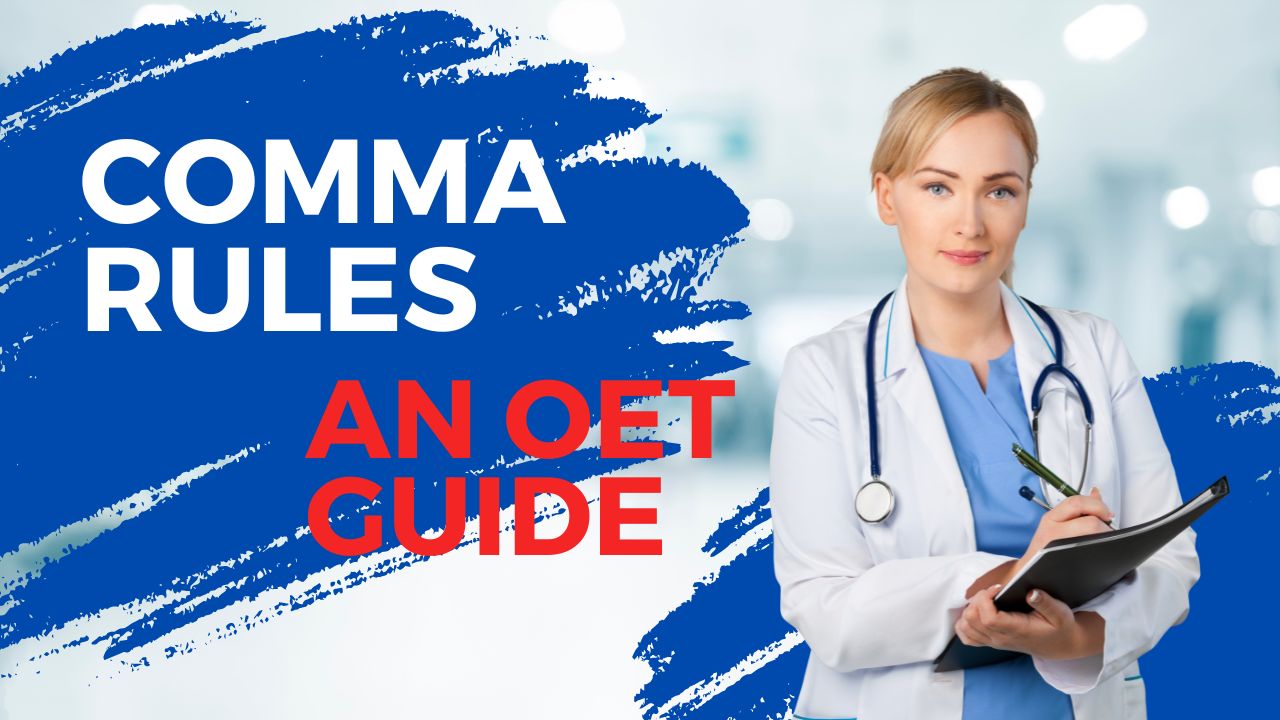An OET Guide on Comma Rules
An OET Guide on Comma Rules: Punctuation, particularly the comma, poses a consistent challenge in any language proficiency test. The comma is small yet mighty, and when you use it correctly, it can significantly enhance your written communication.
Let’s demystify this little punctuation mark and ensure your success in the OET Writing test. Knowing five of the most useful rules about when to use commas will help you ace the test.
OET – Five Comma Rules
Rule 1: Use a comma to separate independent clauses
Commas separate two independent clauses when coordinating conjunctions like ‘and’, ‘but’, ‘or’, ‘so’ join them. You can remember the seven coordinating conjunctions (for, and, nor, but, or, yet, so) with the acronym FANBOYS. The commonly used ones are ‘and’, ‘but’, and ‘so’.
An independent clause expresses a full thought and can stand alone as a sentence.
Example: “Mr Patel was recommended physiotherapy, and he will begin his sessions on Friday.”
Rule 2: Use a Comma After an Introductory Element
In such cases, when a sentence begins with an introductory word, phrase, or clause, it is common to use a comma after the introductory element to separate it from the rest of the sentence.
Example: “During his last consultation, Mr Patel reported improved mobility after his knee replacement surgery.”
Rule 3: Use Commas to Separate Elements in a Series
Use commas to separate each item when listing three or more items. The Oxford comma, which is the final comma before the conjunction (usually ‘and’ or ‘or’), should be used.
Example: “I advised Ms Dave to eat a balanced diet, increase her physical activity, and attend regular check-ups to monitor her diabetes.”
Rule 4: Use a Comma to Set off Non-essential Information
Commas set off non-essential elements in a sentence. A word, phrase, or clause that is not essential to the meaning of the sentence is called a non-essential element.
Example: “Ms Shayan, despite experiencing mild discomfort post-surgery, is recovering well and eagerly want to return home.”
Rule 5: Use a Comma After a Dependent Clause that Begins a Sentence
Often, a comma follows a dependent clause at the beginning of a sentence to indicate the end of the dependent clause and the start of the independent clause, which represents the main point of the sentence. This comma is frequently observed when a sentence begins with a subordinating conjunction such as ‘although’, ‘if’, ‘when’, ‘while’, ‘after’, ‘until’, and ‘because’.
Example: “Although Mr Peterson has made some improvement in his health, he still requires ongoing monitoring of his blood sugar levels.”
An OET Guide on Comma Rules
Three common errors People Make with Commas
Here are some of the most common errors people make with commas (and the corrected sentences).
Error 1: Joining two Sentences with a Comma only (aka a ‘comma splice’)
Using only a comma to join two sentences is incorrect; we can utilize ‘and’, a semicolon, or separate them into two sentences.
Incorrect: “Dr Dan checked the patient’s lab results, he didn’t find anything wrong.”
Correct: “Dr Dan checked the patient’s lab results and didn’t find anything wrong.”
Error 2: Using a Comma with a Defining Relative Clause
A defining relative clause is a clause that you can’t get rid of because it specifically defines some part of the sentence. Don’t separate a defining relative clause from the rest of the sentence with commas.
Incorrect: “The patient who has type 2 diabetes, should continue taking his insulin medication.”
Correct: “The patient who has type 2 diabetes should continue taking his insulin medication.”
Error 3: Using an Unnecessary Comma with two Actions
You don’t need a comma when the same person or thing is doing two things.
Incorrect: “Mrs Philip has a check-up next week, and also needs more tests.”
Correct: “Mrs Philip has a check-up next week and also needs more tests.
In accordance with Rule #1 above, when you have two complete sentences joined by a coordinating conjunction, you should use a comma.
Correct: “Mrs Philip has a check-up next week, and she also needs more tests.”
Conclusion
Remember, using commas correctly makes your writing clearer and easier to read. It also demonstrates a high level of English proficiency, which can help boost your OET writing score. Keep practising, observe how expert writing utilizes commas, and avoid the common errors mentioned above to ensure a successful OET experience.
For more resources on OET check out our Youtube Channel
| 15-hour All-Inclusive OET Course! |

